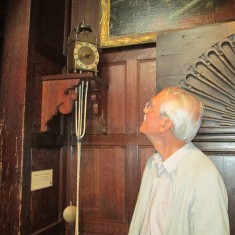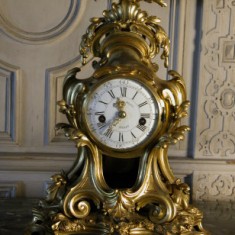John Martin, antiquarian horologist, started looking after all the clocks in the Knole showrooms from 1973 right through the end of the 1990s. Conrad Volk, a Knole guide introduced him to the property, saying “Well, the clocks don’t work at Knole so what about coming up and making them work?” Thus started a long and happy time for John, whose memories include the very first clock visitors see when they visit Knole’s interior.
John Martin
Caring for Knole's clocks for more than 20 years
Interviewed by Christine Nevard and Veronica Walker-Smith
An accolade from Lord Sackville
I was introduced here to Knole with a view to looking after the clocks, by an old friend of my father-in-law’s called Conrad Volk, who was a guide here. So he said: “Well, the clocks don’t work at Knole so what about coming up and making them work?” So he introduced me up here. And that’s how it started. I went round all the clocks. All the clocks in the Trust part, in the public rooms and then Lord Sackville asked me to look at his, and Hugh Sackville-West to look at his. So I ended up looking after all the clocks here except that one up at the top. And that’s how it all started really. And one day, one Monday, I was walking through Lord Sackville’s apartments and he came along and he said: “I’ve lived here all these years and this is the first time that I’ve noticed all the clocks working!”
I'd known Knole all my life, and I loved it
And your care of the clocks in the house and the private apartments: how often did you visit? Once a week?
J.M.: No, no, it was a completely ad hoc arrangement. I had just a casual exchange of letters with the administrator at the time…which said that I would come and visit the house as often as was necessary, in other words he could ring me and tell me he wanted me to look at a certain clock. And I would not charge for that at all because I had known Knole all my life and I loved it.
So you did all this on a voluntary basis.
J.M.: Yes, on a voluntary basis.
The Cromwellian pendulum clock in the Brown Gallery
So this clock was converted in the 18th century to the long pendulum. It has this rope drive for the weight.When I first came here to do these clocks, I came to look at this clock. It was the first one. And it was Hugh Sackville-West who showed it to me. He was actually q uite proud of the fact that he’d changed this…he’d put a hook in here, and a hook up there… and he’d arranged this with another pulley which went up to a pulley on that hook. Another rope down here which had the weight on it, and on the principle that you get much greater drop if you had the weight starting at the top! But … it didn’t work! What he’d forgotten was that by doing that you’d double up the friction losses and you’d need a weight probably three times that to do it. You then increase the friction dramatically on everywhere because of the load of that heavy weight and you’d never be able to drive it with a rope…you’d need a proper chain or something….So I said, I’m awfully sorry but…
It didn’t sound like he’d consulted anyone to do that!
J.M.: No, no, no, they had free run. The Trust were more or less just an overseer at that time. Hugh had the run of the place, and could do what he liked.
Were you suitably horrified?
J.M.: I was slightly surprised, and I said well, I’m sorry I’m going to have to take it all apart, because it won’t work.








No Comments
Add a comment about this page